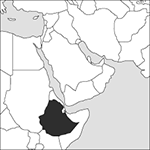
Source: MAPS IN MINUTES™ © RH Publications (1997)
Capital:
Addis Ababa
Area:
1,104,300 sq km (426,373 sq miles)
Population:
93,877,025 (2013 est)
Currency:
1 Ethiopian birr = 100 cents
Religions:
Ethiopian Orthodox 43.5%; Muslim 33.9%; Protestant 18.6%
Ethnic Groups:
Oromo 34.5%; Amhara 26.9%; Somali 6.2%; Tigray 6.1%; minority groups
Languages:
Amharic, English, Arabic (all official); Oromo; local languages
International Organizations:
UN; AU; Non-Aligned Movement
A country, formerly known as Abyssinia, in north-eastern Africa. Sudan is on its western border, Eritrea on its northern border, and Kenya on its southern, while Somalia reaches round it on the east.
Physical
The low-lying Ogaden region in the east is very hot and arid; but the entire centre of the country is a group of volcanic mountain ranges with high plateaux where the air is mild and there is moderate summer rain. The Great Rift Valley runs through these, and the whole area is cut about with ravines and fertile valleys. In the north-west lies Lake Tana, the source of the Blue Nile, while in the south-west forests rise along the slopes of the mountain ranges.
Economy
The Ethiopian economy was centrally planned and based on collectivized agriculture until 1991. Subsistence agriculture remains the mainstay of the economy, with all land owned by the state and long-term leases being granted to tenant farmers. Crops include cereals, pulses, and coffee, the major export. Other exports include khat, gold, and leather products. The principal industries are food processing, beverages, textiles, and leather.
History
By the 2nd century ad the kingdom of Aksum had a brisk trade with Egypt, Syria, Arabia, and India in gold, ivory, and incense, and minted a gold currency. In the 4th century the court became Christian. Aksum collapsed c.1000, and, after a time of confusion, the Zagwe dynasty emerged. In 1270 it was replaced by the Solomonic dynasty claiming lineal descent from Solomon and the Queen of Sheba, bringing the Amharas from the mountains of central Ethiopia to prominence. This may have been known to Europeans in the Middle Ages as the legendary kingdom of Prester John. In the 16th century the Muslims of the lowlands attacked the Christian highlands, but were repulsed in 1542 with Portuguese artillery. When Jesuit missionaries came to Ethiopia Emperor Susenyos was converted to Roman Catholicism (1626). His son Fasilidas (1632–67), having forced him to abdicate, made Gondar the capital. Surrounded by Islam and torn by warring factions, the empire foundered. The only unifying force was the Ethiopian Coptic Church and the empire was not reunited until 1855, when Emperor Tewodros II was crowned, and this was continued during the reign of Menelik II.
Ethiopia successfully repelled Italian attempts at colonization by a decisive victory at Adowa in 1896, but was conquered by Mussolini in 1935–36. The Ethiopian emperor Haile Selassie was restored in 1941 after the Abyssinian Campaigns and in the 1950s and 1960s Ethiopia emerged as a leading African neutralist state. Haile Selassie’s failure to deal with severe social and economic problems led to his deposition by a group of radical army officers in 1974. A subsequent coup brought Colonel Mengistu Haile Mariam to power in 1977, but his centralized Marxist state was confronted by a Somali-backed guerrilla war in Eritrea. Famine broke out on a massive scale (1984–87), and despite Soviet and Cuban military assistance and an international relief effort to alleviate starvation, neither peace nor plenty returned. In May 1991 Mengistu was forced to flee the country by the Ethiopian People’s Revolutionary Democratic Front (EPRDF) and their allies. Peace talks in London resulted in the recognition of an EPRDF government in Addis Ababa, which largely succeeded in restoring order. Eritrea voted to secede and became independent in 1993. A new constitution was adopted in 1994, which gave the regions considerable autonomy. The first multiparty elections (1995) were won by the EPRDF, under Meles Zenawi; they have been re-elected at all subsequent elections, although those of 2005 saw significant political violence. An intermittent border war was fought with Eritrea between 1998 and 2000. Zenawi remained Prime Minister until his death in 2012, when he was succeeded by Hailemariam Desalegn. In 2018 Desalegn resigned amid mass anti-government protests and a state of emergency was imposed across the country. Abiy Ahmed became Prime Minister.
- Miller, Jacques Francis Albert Pierre
- Miller, Stanley Lloyd
- Miller sweep generator
- Miller, William Hallowes (1801–80)
- Miller–Bravais indices
- Miller–Urey experiment
- millet seed paradox
- milli-
- millibar
- milligal
- Millikan, Robert Andrews
- Millikan, Robert Andrews (1868–1953)
- Millikan’s oil-drop experiment
- millimetre-wave astronomy
- millimetre waves
- millimetre-wave technology
- milling
- millipede
- millipedes
- millisecond pulsar
- milli-(symbol: m)
- milli‐
- Mill, James (1773–1836)
- Mill, John Stuart (1806–73)
- Millon’s reagent